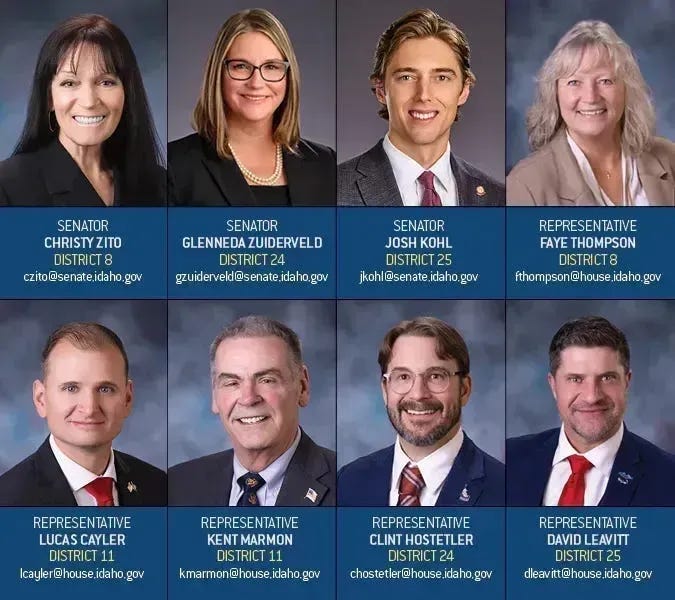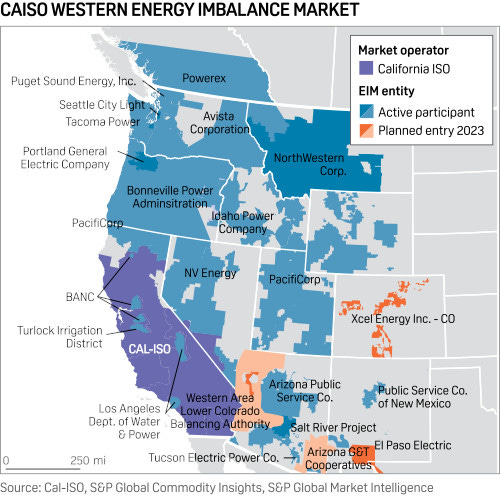Why Idahoans Are Paying More for Their Power Bills
How out-of-state energy mandates and corporate projects are driving up Idaho’s power costs.
In our last update, we exposed how Idaho Power’s proposed rate hike was layered with hidden costs, from “wildfire mitigation” expenses to federal compliance spending, pushing us closer to California’s energy model. Representative David Leavitt (District 25) takes that investigation a step further.
In the piece below, he unpacks how Idaho’s energy future is being shaped not in Boise, but in Sacramento, Olympia, and Washington, D.C., and how Idahoans are footing the bill for policies they never voted for.
If you haven’t already, we encourage you to submit a public comment to the Idaho Public Utilities Commission and make your voice heard. Be sure to reference Case No. IPC-E-25-16 in your submission. These rate increases and land use decisions affect every Idaho family, farmer, and small business. It’s time to speak up.
Key Issues Covered in This Report:
This in-depth article from Rep. Leavitt covers several critical areas:
California’s mandates and their effect on Idaho’s energy market
Out-of-state wind and solar development on Idaho land
Massive transmission infrastructure, and who it really serves
Tech giants like Meta and Micron and their growing energy demands
How current policies punish homeowners and favor utilities
The impact on Idaho families, farmers, and small businesses
In Liberty,
Senator Christy Zito, District 8
CZito@senate.idaho.gov
Senator Glenneda Zuiderveld, District 24
GZuiderveld@senate.idaho.gov
Substack: @glenneda
Senator Josh Kohl, District 25
JKohl@senate.idaho.gov
Substack: @joshkohl4idaho
Representative Faye Thompson, District 8
FThompson@house.idaho.gov
Representative Lucas Cayler, District 11
LCayler@house.idaho.gov
Substack: @lucascayler
Representative Kent Marmon, District 11
KMarmon@house.idaho.gov
Substack: @kentmarmon
Representative Clint Hostetler, District 24
CHostetler@house.idaho.gov
Substack: @theidahoresolve
Representative David Leavitt, District 25
DLeavitt@house.idaho.gov
Substack: @leavitt4idaho
Why Idahoans Are Paying More for Their Power Bills
by Representative David Leavitt, District 25
Across Idaho, families, farmers, and small business owners are opening their monthly utility bills and doing a double-take. Electricity costs are rising, and not just by pennies. For many, it feels like another hit in a season of economic strain. But while the increase is real, the reasons behind it are far more complicated than a spike in temperatures or fuel prices. What’s really happening is that Idaho’s power market is being shaped by forces well beyond our borders—driven by regional energy politics, renewable energy mandates in other states, and federal land management policies that are reshaping the landscape of Idaho itself.
At the heart of the issue is Idaho’s participation in the Western Energy Imbalance Market, or WEIM. This is a multi-state energy trading system run by the California Independent System Operator (CAISO)1, which allows states in the West to buy and sell electricity in real-time.
On the surface, this sounds practical. It allows for better grid coordination and can reduce waste. But in reality, this system is increasingly used by states like California, Oregon, and Washington to meet their aggressive green energy mandates2, at Idaho’s expense. While those states have enacted strict laws to eliminate fossil fuels and shift to 100% clean energy by 2045, Idaho has no such mandate. Yet our state is building the infrastructure to help them meet theirs.
Because California can’t meet its own energy goals internally, it relies on other states—particularly Idaho—to send it electricity generated from renewable sources like wind and solar. This has led to a boom in green energy development in our state, much of it driven not by local need but by out-of-state demand. Projects like the Lava Ridge Wind Farm3, which proposes placing hundreds of turbines across public lands in southern Idaho, are designed primarily to export energy out of state. These are massive developments, spanning miles of rural land, disrupting ranching operations, wildlife migration paths, and historic sites. And they’re not being driven by Idahoans, but by corporations responding to incentives from other states and federal subsidies.
Supporting these export-driven projects are high-voltage transmission lines and substations, such as the Southwest Intertie Project (SWIP-North) and the Great Basin Substation. These are not minor upgrades—they are industrial-scale projects stretching hundreds of miles and designed specifically to move green energy from Idaho to population centers on the West Coast. The SWIP-North line alone runs approximately 285 miles to connect renewable energy from southern Idaho and Nevada to the broader western grid4. This infrastructure exists not to serve Idaho homes and farms, but to funnel electricity to California’s energy-hungry urban centers.
Meanwhile, Idaho’s own utility companies are taking advantage of the green gold rush. Idaho Power, for example, has made major investments in renewable infrastructure—not necessarily to serve Idaho ratepayers, but to sell power to neighboring states that pay a premium for green energy. And because utilities are allowed to recover these costs from their customers, Idaho residents end up footing the bill. The Idaho Public Utilities Commission approved a $50 million rate increase for Idaho Power in 2025, raising the average household bill by $3.50 per month5. Rocky Mountain Power has proposed even larger increases, citing rising fuel and infrastructure costs.
Adding even more pressure to the grid are three massive energy-intensive projects now underway in southern Idaho. Micron’s $15 billion semiconductor expansion in Boise is projected to create 2,000 jobs and significantly increase energy demand, with a goal of sourcing 100% renewable power by 20256. In Kuna, Meta is building a nearly one-million-square-foot data center that will become Idaho Power’s single largest energy customer7.
Nearby, Diode Ventures—an affiliate of Black & Veatch—is developing the 620-acre Gemstone Technology Park, a multi-building data center complex with strong indications that Google may be involved8. These developments are not only driving up electricity demand but also accelerating the push for more transmission, solar, and wind infrastructure across Idaho.
These increases are layered on top of regulatory mechanisms that ensure utilities get paid, even when customers use less electricity. Programs like the Fixed Cost Adjustment (FCA) and Power Cost Adjustment (PCA) allow companies to shift costs to consumers regardless of usage9. That means even when you turn down the thermostat or shut off the lights, your bill might still go up, because the system is designed to protect utility profits first.
And if you’re one of the many Idahoans who invested in residential solar panels, thinking you could reduce your dependence on the grid and maybe even earn credit for the power you produce, the reality has likely been a disappointment. The Idaho Public Utilities Commission (IPUC) has placed a cap on residential solar generation, limiting customers to systems producing no more than 25 kilowatts and capping export credit compensation at 25 megawatt-hours annually10. Once a customer exceeds that threshold, they are paid significantly less, only a fraction of what they would receive under net metering. At the same time, Idaho Power has proposed reducing the credit rate from over 8 cents per kilowatt-hour to as low as 2.46 cents11.
In contrast, commercial solar farms—many of which export energy out of state—face no such production limits and are compensated under different regulatory structures, often with long-term contracts and utility-scale pricing. This double standard punishes Idaho homeowners who made responsible, forward-thinking investments in renewable energy while rewarding large corporate entities and their developers12. Instead of empowering individual energy independence, the state’s current policy structure discourages it, leaving families with rising costs, a reduced return on their solar investments, and the sense that the system isn’t built to support them.
All of this is happening with little say from the people who are most affected. In places like Jerome, Minidoka, and Lincoln counties, landowners are watching as public and private lands are being cleared for solar panels and wind farms. Transmission lines are being routed through farm fields and along scenic corridors. Federal land agencies, like the Bureau of Land Management, are fast-tracking approvals for projects that serve national green energy goals, not local needs. And the costs—economic, environmental, and cultural—are being borne by Idaho communities.
It’s easy to paint this as progress, and some certainly profit from it. But for the average Idahoan, especially in our rural counties, it feels more like being steamrolled. We’re being asked to subsidize energy policies we didn’t vote for, and to sacrifice our land, our heritage, and our wallets so California can meet its carbon goals. And while the utilities and developers reap the rewards, the ratepayers—farmers trying to irrigate crops, families running air conditioning in the summer heat, and small businesses managing razor-thin margins—are left holding the bill.
The question Idaho must ask is simple: Who is our energy policy really serving? If we’re going to build the infrastructure, endure the land use impacts, and pay the rising rates, shouldn’t our families and communities be the first to benefit? Until that answer changes, Idahoans will keep seeing higher bills, while someone else gets the power.
Renewable Portfolio Standards - Oregon.gov, energy.ca.gov, commerce.wa.gov
2024 Distributed Energy Resources Annual Report
Paid subscribers to this Substack will be recorded on Zito For Idaho’s sunshine report as a contribution to a political candidate. Subscribers don't have special access or content. I appreciate your support.








Thank you so much for this insight!
So you are our representative, what are you and the other reps going to do to correct laws that allow us regular people to be abused by the current system and big corporations to profit? What is going to be done to make infrastructure upgrades that will not be used by us be paid by those who use it? I would say if Idaho residential energy is completely covered by what we already produce (including the annual increase in our residential population), and if normal business use (non mega ton wattage businesses) is covered, then we can prove there is no need to shut down coal or create more renewables. This should be easy to gather (how much energy is produced now, how much residential and business customers use minus what mega ton watt users use). The power companies already know those figures (if they will share them). That is enough to prove small business and residential users do not need the upgrades or change to renewables and therefore the burden to pay for changes should be on those who will use the energy and not the rest of us. We should not be used to subsidise other states mandates to change energy sources and create more unreliable energy when coal and nuclear have worked great for a long time.